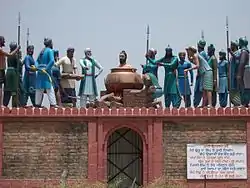Bhai Dayala
Bhai Dyala ji (Punjabi: ਭਾਈ ਦਿਆਲਾ ਜੀ, Hindi: भाई दयाला जी; died 9 November 1675), also known as Bhai Dyal Das, was an early martyr of the Sikh ethos[1] He was martyred alongside his companions Bhai Mati Das and Bhai Sati Das and the Ninth Guru, Guru Tegh Bahadur.
Bhai Dayala | |
|---|---|
 Depiction of Bhai Dayala being boiled alive. | |
| Born | unknown |
| Died | 11 November 1675 Delhi, India |
| Cause of death | Death by boiling |
| Known for | Martyrdom, Being Masand of the Patna Sangat and responsible for Patna Suba. |
Service of Guru Har Krishan
Dhyal Das was born in a poor Brahmin family. Bhai Dayala was one of the twenty five or so Sikhs, alongside Mata Sulakhni (Mata Kishan), that accompanied Guru Har Krishan when he left Kiratpur to visit King Aurangzeb in Delhi in 1604.[2]
Service of Guru Tegh Bahadur
Bhai Dayala was one of the Guru's most dearest and closest companions.[3] Bhai Dayala was the chief of the sangat (holy congregation) at Patna Sahib and enlisted incharge of all the masands in the east,[4] and when the Guru's son Gobind Rai (Gobind Singh) was born it was him who sent Guru Tegh Bahadur a letter, who was at Dacca, informing him of his son's birth.[5]
Bhai Dayala helped take care of the Guru's son with the help of Bhai Kirpal[6] and was with the Guru at Lakhnaur where the Guru was with his family and son Gobind Rai when they came from Patna and headed to Baba Bakala around 1672.[7]
When the Guru left Anandpur Sahib on July 11, 1675 where he would head towards Delhi to meet Aurungzeb he was accompanied by Bhai Dayal Das, Bhai Mati Das, and Bhai Sati Das.[8]
Arrest
Bhai Dayala was one of the Sikhs who accompanied Guru Tegh Bahadur when the latter left Anandpur for Delhi on 11 July 1675, the other two were brothers---Bhai Mati Das, a Dewan and Bhai Sati Das, a Scribe at Guru’s court. Along with the Ninth Guru, they were arrested on orders of Emperor Aurangzeb at Agra.
Martyrdom
On November 11, 1675 after Bhai Mati Das' execution Bhai Dayala refuted with temperament against the Mughals calling Aurangzeb a tyrant and cursed him for committing atrocities in the name of God and religion and said there would be a demise of the Mughal empire.[9] Bhai Dayala was tied with an iron chain like a bundle then was made to stand erect into a big cauldron full of water with only his head and shoulders seen.[10][11] The vessel was then heated to the boiling point as Bhai Dayala began to recite Japuji Sahib.[10]:100 He was then roasted into a block of charcoal.[12][13]
See also
References
- Oberoi, Harjot. (1994). The Construction of religious boundaries : culture, identity, and diversity in the Sikh tradition. Chicago, IL: University of Chicago Press. ISBN 0-226-61592-8. OCLC 30157084.
- Gandhi, Surjit (2007). History of Sikh Gurus Retold II: 1606-1708 C.E. New Delhi: Atlantic Publishers & Dist. p. 605. ISBN 978-81-269-0858-5.CS1 maint: ref=harv (link)
- Gandi (2007), p. 664.
- Johar, Surinder Singh (1997). Guru Tegh Bahadur: A Bibliography (First imprint ed.). New Delhi: Abhinav Publications. p. 126. ISBN 978-81-7017-030-3.
- Gandhi (2007), p. 687.
- Singh, Darshan (1975). The Ninth Nanak: A Historical Biography. Jullundur: K. Lal. p. 71. OCLC 4835560.
- Gandhi (2007), p. 638.
- Gandhi (2007), p. 661.
- Lakshman, Bhagat (1995). Short Sketch of the Life and Works of Guru Gobind Singh (AES Reprint ed.). New Delhi: Asian Educational Services. p. 15. ISBN 978-81-206-0576-3.
- Siṅgha, Guraprīta (2003). Soul of Sikhism. A.H.W. Sameer series. New Delhi: Fusion Books. p. 100. ISBN 978-81-288-0085-6. OCLC 495613935.CS1 maint: ref=harv (link)
- Bakshi, Ram; Mittra, Sangh (2002). Saints of India: Guru Gobind Singh. Criterion. p. 287.
- Gupta, Hari Ram (1984). History of the Sikhs: The Sikh Gurus, 1469-1708. Munshiram Manoharlal. p. 386. OCLC 923129193.
- Sharma, B. R., ed. (1987). Punjab District Gazetteers: Rupnagar. Gazeteer of India. Chandigarh: Revenue Department, Punjab. p. 56. OCLC 863422953.
